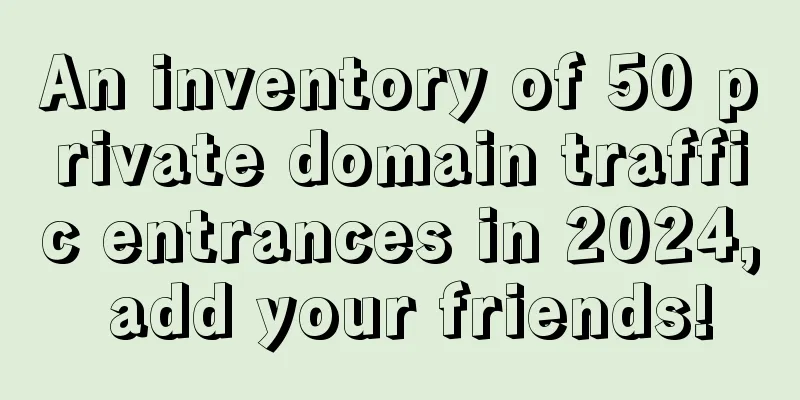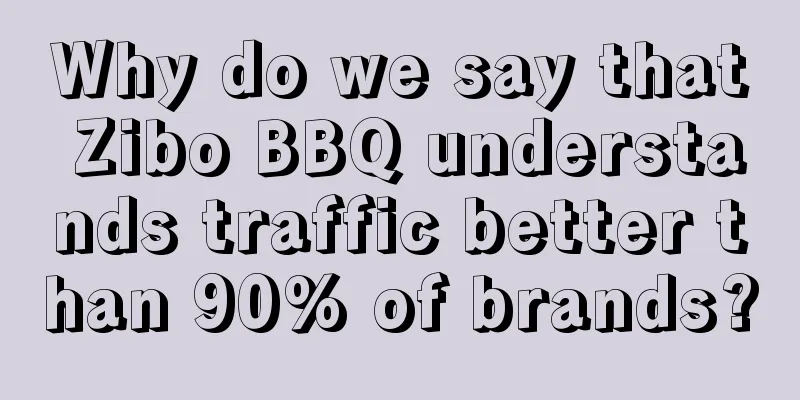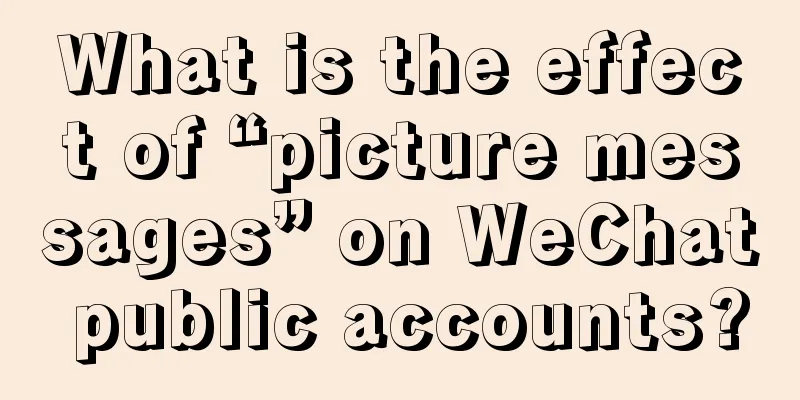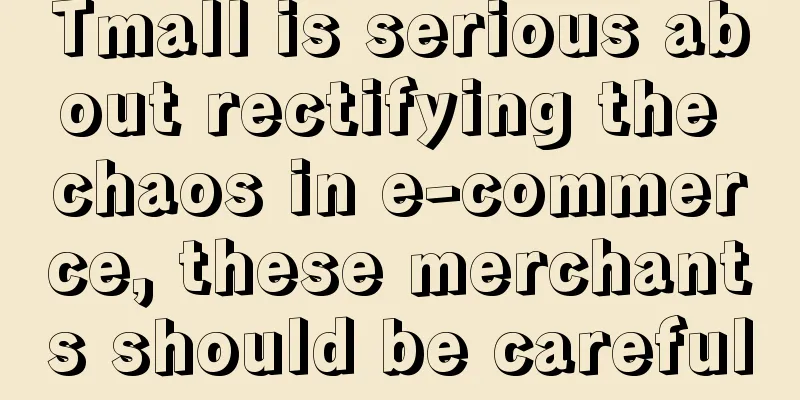Haidilao and Starbucks are both using MBTI marketing. What is the logic behind it?

Are you an "i person" or an "e person"? This sentence has become a social opening statement for many young people today. The "i" and "e" representing introversion and extroversion respectively come from the MBTI personality test which has become very popular in the past two years. Data shows that in the past few months, the popular topic #万皆可MBTI-related notes on Xiaohongshu has accumulated more than 2.12 billion views. On the Douyin platform, the total number of views of related topics has reached 3.2 billion. MBTI is popular not only on social media, but also in brand marketing activities. Haidilao, Starbucks, Perfect Diary... More and more brands are starting to market based on MBTI. So what is the reason for MBTI's popularity? How do brands use it for marketing? Let's analyze the logic behind it. 1. Why is the MBTI test so popular?Let’s first talk about what the MBTI test is. MBTI uses four dimensions: attention direction, cognitive style, judgment style, and lifestyle. Each dimension has a corresponding test question, which can measure four groups of different personality traits: extroversion (E) and introversion (I), sensation (S) and intuition (N), thinking (T) and feeling (F), judgment (J) and perception (P). Finally, the test results are arranged and combined to form 16 personality types, such as "ESTJ" or "INFP". Although the MBTI test has 16 personality types, E and I are the most popular and easiest to identify . E represents the optimistic and outgoing type who pays attention to the outside world. To put it bluntly, it is the "social bull". I is just the opposite, representing the introverted and reserved type who pays attention to the inner self. It is also called "social phobia". So, how did the MBTI test become so popular? In my opinion, it became so popular because it caters to a certain need (psychological) of contemporary young people. First, it caters to the need for self-exploration. From ancient times to the present, human beings have never stopped the pace of knowing themselves. The ancient Greek sage Socrates used "know yourself" as a mantra. In our daily lives, we are always constantly confirming who we are and what kind of people we are. However, how easy is it to know yourself correctly? Compared to the obscure psychology, the MBTI test has no threshold. Ordinary people only need to spend 15 minutes and answer a few multiple-choice questions to quickly understand their personality type. This is to know yourself. Through big data, we can efficiently screen out similar people, find "like-minded" people, join an organization or group (such as XX fan club), and gain a sense of identity and belonging. Second, it can beautify people's behavior. In today's social media, photo-editing seems to have become a kind of "social etiquette", and people have a strong sense of insecurity about photos of their bare faces without filters. To some extent, we can also regard the MBTI test as another form of "personality filter." This theory and test results will tell you that "people's personalities are not good or bad, they are just our innate characteristics," "we should live in an environment that suits our personality," and so on. For some people, the results of the MBTI test can make them accept the current situation with peace of mind, and even strengthen their own behavior. For example, I am a person who is born introverted and not sociable. So I am not good at communication. It is not my fault, but determined by my genes. Furthermore, it is also a social currency. People can use the test to understand their own personality type, as well as the personality type of others. This interactive nature has led to the test being widely spread and shared on social media. For example, the popular topic on Xiaohongshu #万万届可MBTI-related notes has accumulated more than 2.12 billion views. In addition, for some people who want to expand their social circle but don’t know where to start, the MBTI test is a good entry point. The sentence "What are your MBTI test results?" can become a universal topic for young people to make friends and break the ice, just like travel, food and weather. 2. Brands are focusing on "MBTI marketing"The popularity of MBTI test on social media has also attracted the attention of brands. After this trend spread to the marketing field, major brands have also actively thought about how to interact with young people and put a lot of thought into it. As a result, we saw a lot of "refreshing" ideas. For example, in July this year, Starbucks and the official MBTI organization launched the "Social Personality Test" interactive H5, which uses 10 new test questions to briefly analyze the user's personality, and when the personality type results are obtained, the corresponding new coffee is recommended to the user. Starbucks's move to keep up with the trend immediately captured the hearts of young people who like to try new things, and it became a huge sales topic. Some time ago, Haidilao launched exclusive waiting areas for i-people and e-people in some of its stores in Beijing. In addition, exclusive signs for i-people and e-people will be distributed on site. Although this move has sparked intense controversy online, traffic is money. Some customers even said they were willing to go to the store for this dining experience. From this point of view, it can be regarded as a successful marketing campaign. Haidilao is not the first company to try this approach. A few years ago, Watsons launched a similar service, setting up two labels at the entrance to cater to consumers with social phobia and social skills. This service became a hot topic on the Internet at the time by amplifying the characteristics of "i-people" who tend to choose alone when shopping and are unwilling to communicate with others. Not only the catering industry, but also the service industry, jewelry industry, and even the aviation industry are making a big fuss around different personality traits. These different attempts are all customized services made by brands based on consumers' "personality characteristics". Because they have insight into consumers' needs, they have naturally received widespread praise. 3. How can brands leverage “MBTI” to carry out marketing?Why are some brands so popular while others are ignored, all leveraging the "MBTI"? How should brands create a successful "MBTI marketing"? Here are three key points for your reference. 1. Output customized content (triggering social communication)If a brand wants to take advantage of the trend and break through the circle, the most effective way is to combine the hot spots with its own brand and output customized content with interesting content. Only a clever combination can trigger social dissemination. At the same time, with the help of appropriate media placement, the effect can be maximized. For example, in August this year, Ele.me and Lelecha launched a new slogan: "Do e for i, this cup is on me", exploring "100 reasons why I'll treat you". Among them, the advertising copy borrowed the currently popular MBTI theme, which attracted the attention of many people and was spontaneously shared on social platforms, thus breaking the circle. 2. Segment product themes (strengthen identity)When selling to the market, brands usually have to give users a fixed portrait. Based on the four dimensions of MBTI alone, consumers can be divided into 16 market segments, each with its own personality traits and consumption characteristics. For example, INTP consumers may prefer logical, innovative, and high-quality products, while ESFJ consumers may prefer practical, user-friendly, and socially responsible products. Perfect Diary has launched targeted product marketing based on the 16 personality traits of MBTI, providing suggestions on lipstick colors for people with different personalities. For example, for the rigorous and logical realist (ISTJ), whose personality is steady and gentle, red bean paste and cinnamon are recommended. For the excellent manager (ESTJ), whose personality is calm and generous, crimson and rust red are recommended. With the marketing of "starting from MBTI to explore more possibilities for yourself", the product is cleverly linked with user consumption tendencies, making the marketing more convincing. 3. Create exclusive scenarios (product experience)If the purpose of brand product segmentation is to strengthen identity recognition and closely connect segmented groups with products, then scene creation is to make the brand's products (services) more attractive. Take Huawei FreeBuds Pro 3 headphones as an example. The brand creates different usage scenarios based on the distinct personality traits of I people, E people, J people, and P people. For example, person I is an introvert and likes to listen to music alone to relax himself, while person E is keen on sharing and socializing, and is happiest when listening to music together. By connecting audiences with different hobbies and personalities, different groups of people can have a highly immersive product experience. 4. Final ThoughtsIn this fast-changing era, the success of a brand is inseparable from its sensitive insight into consumers and its flexible response. Nowadays, more and more brands are beginning to engage in MBTI marketing. However, brands must keep a clear head and avoid blindly following trends. Before rushing to cater to young consumer groups, we must first deeply understand their real needs. Only by truly understanding the inner demands of young consumers can brands find a breakthrough in "MBTI" marketing and provide them with valuable and in-depth services and experiences. Author: Yan Tao WeChat public account: Yan Tao Sanshou |
Recommend
With an annual income of 20 billion, the snack version of Pinduoduo is hunting for county towns
Why are discount snack stores growing so fast in t...
Shoptop adds the "one-click store move" feature
Shoptop announced that in order to address the pai...
Roasted cactus, roasted watermelon...all kinds of weird barbecues are popping up, and netizens are calling for help!
The "weird trend" in Chengdu's barbe...
The most comprehensive review | 6 ways to monetize your own media account
In today's information society, public account...
Zhou Hongyi's IP business is not just about traffic.
In the digital age, how entrepreneurs use emerging...
Memories and reflections: My years in a major Internet company
This book reviews the author's career in a lar...
Can high school students engage in cross-border e-commerce? How to do it?
In today's Internet era, cross-border e-commer...
Do you sell on Amazon? What qualifications do you need to sell food?
With the development of e-commerce platforms, more...
Australia's new "top streamer" tells a "new story" about outbound travel
Who is Australia's new top influencer? With th...
Why is Pangdonglai’s tea so popular?
Is it the unique taste of the product that makes P...
One video gained 140,000 followers. This track is making rapid progress on Xiaohongshu
A video about dismantling a home gained 140,000 fo...
What should you pay attention to when following others on Amazon?
The benefit of Amazon follow-selling is that it sa...
The great voyage of brands is ultimately a battle for value/cost ratio
What we want to talk about is not only a concept, ...
How to combine private domain business with ChatGPT
ChatGPT has not been launched for a long time, but...
Temu, are there many pitfalls overseas?
This article explores the business model of Temu, ...









